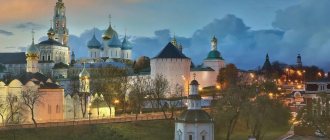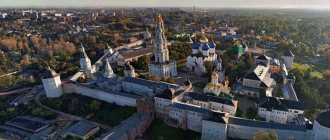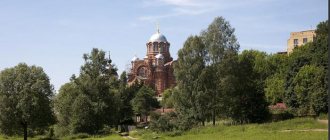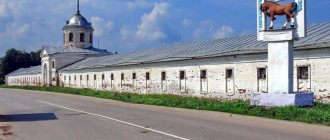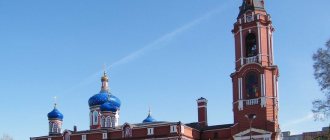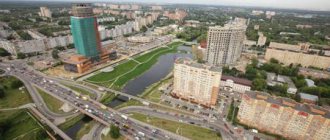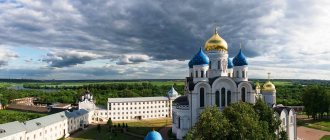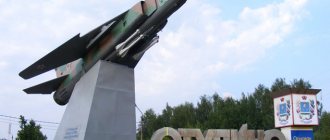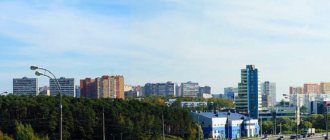The Trinity Lavra of Sergius is a visiting card, the main significant place of Sergiev Posad. It was she who gave rise to the formation of the city and became the pride of Russian Orthodoxy. From the moment of its foundation and in all subsequent times, this monastery has been and remains one of the main attractive spiritual and cultural centers. It is impossible to walk around, comprehend and evaluate all the buildings of the Lavra, and there are more than 50 of them, in one or two visits.
The monastery was always reconstructed, remodeled and updated. Life activity in it did not stop or freeze for a minute, and, probably, not a single building retained its original image. Several roads lead to the Lavra; the main gate is the Holy Gate with the Church of the Nativity of John the Baptist, built in the 17th century.
Every year, thousands of believers make a pilgrimage to the Trinity-Sergius Lavra to see the shrines of the monastery, get acquainted with its history and architecture, and take part in divine services.
Hotels near the Trinity-Sergius Lavra
Trinity-Sergius Lavra - the spiritual monastery of the Russian Church
Not far from Moscow, in the city of Sergiev Posad, there is the largest Orthodox monastery in Russia. Its church name is Holy Trinity Sergius Lavra. Created almost seven centuries ago, today it is the educational center of the Russian Orthodox Church. One of its cathedrals houses the relics of the founder of the Lavra, the spiritual ascetic of all Rus' - Sergius of Radonezh.
The beginning of the twentieth century - fate during the revolution
Until 1917, the life of the Holy Trinity Lavra of St. Sergius can be called active - it carried out spiritual and educational missions, it was the largest pilgrimage center in Tsarist Russia.
In 1919, after the revolutionary events, the monastery was closed and its property was nationalized. The monks are expelled along with the governor of the monastery. At the same time, the new government is aware of the historical and cultural value of the monastery.
To preserve the heritage and save it from looters, a commission is being created that is designed to evaluate the property of the Lavra from the point of view of its artistic and historical value. The commission included deeply religious people who not only described and evaluated, but also did everything possible to preserve the spiritual heritage.
It is important to know: after the nationalization of the Lavra’s property, monks became the new caretakers and watchmen. A huge amount of work was undertaken to preserve the heritage and especially the relics of St. Sergius. For many years, some of the relics were hidden; everything was done to prevent them from being desecrated and destroyed.
In the 1920s, a museum was opened here, which later acquired the status of anti-religious. The main struggle unfolded around the relics of St. Sergius, which for several decades were exhibited as the main exhibit of the museum. The Zagorsk Museum of History and Local Lore, as the place was now called, gradually deteriorated, the buildings were destroyed and lost their original appearance, many buildings were rebuilt into living quarters, schools and warehouses.
How to get to the Trinity-Sergius Lavra
You can arrive to Lavra by electric train from the Yaroslavsky station, which runs from the Komsomolskaya metro station to the suburban station Balakirevo, or to the Alexandrov station. It is also convenient to get there by bus from VDNH. Route No. 388 goes to Sergiev Posad, the interval between buses is only 10-15 minutes. All information can be found on the official website of the Trinity-Sergius Lavra.
Service Schedule
Main services on weekdays:
5.30 – general prayer service at the relics of St. Sergius;
6.15, 6.30, 9.30 – liturgies – Assumption, Trinity, Refectory churches.
Funeral services - after the early and late liturgy:
9.00, 13.00 – custom prayer services (except Mondays);
17.00 – cathedral prayer service with akathist to the Mother of God (Friday) – Trinity Cathedral;
From 8.30 to 20.30 – prayer services with an akathist to St. Sergius – Trinity Cathedral.
Confessions are held until 10.30 in the St. John the Baptist Gate Church.
Sundays and holidays, opening hours:
17.00. – all-night vigil;
5.30, 6.30, 8.30, 9.30 – liturgies – Assumption, Trinity, Refectory churches;
from 5.00 to 6.15 and from 8.30 to 20.30 - prayer services to St. Sergius - Trinity Cathedral;
17.00 – cathedral prayer service with akathist to St. Sergius (Sunday) – Trinity Cathedral.
Confessions are held until 7.30 and after the end of the all-night vigil in the Church of St. John the Baptist.
For several centuries, the Trinity-Sergius Lavra has attracted pilgrims and visitors. Even during the time of its founder, people flocked here for support and protection. Today, the Lavra equally warmly welcomes all guests - from the curious to those who seek to come here with prayers.
By visiting the Lavra, you can plunge into the atmosphere of unhurried sincerity, deep thoughts, feel or rediscover yourself. After all, it was here that for many centuries people felt the closest connection with God.
Watch an interesting video about the Trinity-Sergius Lavra:
Excursion into the history of the monastery
Founded by Sergius of Radonezh in 1337, today the Lavra reports directly to His Holiness the Patriarch. During the history of its existence, the oldest Orthodox monastery has worthily endured the consequences of the heyday and periods of oppression by state authorities. In 1920, the Lavra closed. Part of its complex was used to store museum exhibits, and part was converted into residential premises. The revival took place in 1946 and subsequent years.
The Lavra preserves the relics of not only the clergy, but also the royal Godunov dynasty. Buried on its territory are: publicist and Slavophile Ivan Sergeevich Aksakov, doctor, diplomat and thinker Konstantin Nikolaevich Leontyev, Russian philosopher and critic Vasily Vasilyevich Rozanov, and other cultural figures who served for the benefit of the development of Russian and world spirituality. The active role of the spiritual capital was inherent in the Lavra throughout the entire historical stage of its existence.
This place is associated with the names of the ascetics of Russian Orthodoxy - St. Maxim the Greek, Nikon of Radonezh, Epiphanius the Wise and other representatives of the Church. The monastery received its venerable Lavra status in 1744. From the beginning of the 16th century to the present day, a unique library of spiritual culture from handwritten and printed spiritual works is gradually being formed here.
The Lavra received its beginning as a spiritual and educational center in 1814. At this time, the Theological Academy, founded back in 1685, was located here. Today, the operating monastery continues to play a leading role in the educational, educational and spiritual spheres of the Orthodox Church.
A little history
In 1337, the future saint Reverend Sergius founded the monastery of the Life-Giving Trinity on Makovets Hill near Moscow. Gradually, the same seekers for the salvation of the soul gathered around him. The authority of the abbot continuously grew, it was he who blessed Prince Dmitry Donskoy for the battle with Temnik Mamai, the victory on the Kulikovo field became fateful for the young state. Later, during the Time of Troubles, the monastery withstood the siege of the Lithuanians, but was burned by Khan Edigei. And it was revived again, becoming the largest cultural center of the country. In 1920, the monastery was converted into a museum, but in 1946 it was returned to the church. Until 1983, the residence of the Patriarch of the Russian Orthodox Church was located here.
Bell tower of the Lavra
Bell tower of the Lavra, years of construction - from 1741 to 1768. The height of the Trinity-Sergius belfry is 88 meters, it was built according to the design of the architect D. V. Ukhtomsky. The five-tiered bell tower is considered the most beautiful in Russia. Here is the largest, weighing more than 70 tons, the Tsar Bell. The restoration of the belfry was carried out only in 2014, on the eve of the celebration of the 700th anniversary of St. Sergius.
The end of the twentieth century - the beginning of restoration
The Lavra resumed its spiritual activities in 1946, becoming at the same time an artistic and architectural reserve and a monastery.
In Soviet times, it combines monastic life with the life of a museum, welcoming tourists and pilgrims. Since the 1970s, Councils have been held here, which have become a new stage in the revival of the active spiritual life of the monastery. Already by the 40s. In the 20th century, architectural structures became very dilapidated.
After the end of the war, major restoration work began to restore the architectural and artistic heritage of the Lavra, which took more than 30 years. In 1993, the Lavra was included in the UNESCO World Cultural Heritage List.
Assumption Cathedral
Assumption Cathedral. Construction was carried out in 1585 by decree of Ivan the Terrible. The five-domed cathedral was built in the center of the Lavra. The central golden dome was erected in honor of the Savior, the remaining domes, designed like a starry sky, are in honor of the Holy Mother of God. Externally, this is the most fundamental of the Lavra’s cathedrals. Inside, if you enter it, you create an amazing feeling of space, height and abundance of light. The temple remained unpainted for almost a century, and only in 1684, at the expense of Archbishop Moses of Ryazan, master icon painters were invited and under the leadership of Dm. Plekhanov Cathedral was decorated with frescoes depicting saints and noble persons of the princely family. The main shrine of the Cathedral remains the funeral of Sergius of Radonezh.
Development during the period of the 17th - early 18th centuries
The time of troubles at the turn of the 16th-17th centuries only proved the inviolability of the monastery. Polish troops were unable to take the monastery for 16 months, defended by monks and a small military garrison. At the same time, monastic life was not disrupted - services were held, sacraments were performed. However, the events of the Time of Troubles forced the monks to almost double the thickness of the walls.
Royal Pilgrimage Palace – Halls
Since the time of Sergius of Radonezh, the monastery has been a place of pilgrimage for kings. Ivan the Terrible and Boris Godunov came here for advice and reflection. In modern times this tradition is not broken. A new royal pilgrimage palace is being rebuilt - the Halls, which stood in place of the royal chambers of Ivan the Terrible; the Hospital and Refectory Chambers, various buildings, and Sacristies are being erected.
Temple construction continues. At the end of the 17th century, on the square in front of the Assumption Cathedral, the Overkladeznaya Chapel, installed over the miraculous spring, the Refectory Chamber and the Refectory Church, the gateway church of John the Baptist, were erected.
Interesting information: at almost all times the monastery provided not only spiritual support to Russian sovereigns, but also contributed a significant portion of income to the Russian treasury. Thus, Peter I borrowed money to wage the Northern War from the Holy Trinity Monastery.
The monastery continues to remain a witness of Russian history - here in 1682, during the Streletsky rebellion, Princess Sophia and the princes Peter and John were hiding, here the fate of the Russian throne was decided and Peter I became the sovereign of Rus'.
Church of the Solovetsky Wonderworkers
Church of the Solovetsky Wonderworkers. Construction time: 1635-1637. This is the only tented temple in the Lavra, which houses a shrine - the ancient icon “The Sign”, with the image of Zosima and Savvaty of Solovetsky, appearing before the appearance of the Mother of God. The temple is part of a complex of buildings created in different historical periods, the buildings of which house the monastery library, the chambers of the governor of the Lavra and the Cathedral Chamber.
Church of St. John the Baptist
The Church of St. John the Baptist (1693-1699) was created on the site of the main gate to the Monastery and was erected at the end of the 17th century at the expense of the philanthropist G. Stroganov. At the time of its construction, the haram looked somewhat different; the five-domed structure was restored at the end of the last century, already under the leadership of V.I. Baldin, this architectural solution emphasized the stylistic commonality of the entire ensemble of the Trinity-Sergius Lavra. The magnificent iconostasis in the Church of St. John the Baptist is well lit and surprises with its splendor.
Mid-18th century - reign of Empress Elizabeth Petrovna
The reign of Elizabeth I leads to the restoration of the monastery's former glory. The daughter of Peter I loved to visit these places, accompanying her visits with magnificent holidays and fireworks.
It was Elizabeth I who issued a decree in 1744 on the transfer of the Holy Trinity Monastery in Sergiev Posad to the highest status of a lavra. This emphasized the significance of the monastery in the spiritual landscape of Russia and confirmed its central place in the life of the Orthodox.
Mikheevsky Church
By order of the Empress, new temple buildings are being erected in the monastery - the Smolensk Church, the Mikheevsky Church, the Metropolitan's Apartments, and the famous five-tier bell tower.
At the end of the 18th century, an obelisk was erected on Cathedral Square, commemorating the services of the Holy Trinity Sergius Lavra to the Fatherland. During this period, the Lavra continues to be recognized as a spiritual stronghold of the Fatherland.
Refectory Church
Church of St. Sergius with the Refectory Chamber (1686–1692).
These are not all the temples and cathedrals of the Trinity-Sergius Lavra. Each of the buildings has its own history, characteristics and spiritual and cultural value. And all together they form an amazing place, the center of history, spirituality, artistic rarities and the center of spiritual Orthodox culture in Rus'.
In addition to churches and temples, on the territory of the Lavra there is a source of spring water, where anyone can quench their thirst.
It seems important to say a few words about the founder of this center, hieromonk of the Russian Church Sergius of Radonezh (1314-1392). His name personifies the beginning of Russian spirituality. Despite the fact that he did not leave written evidence, he preserved his memory in his spiritual mentoring, as well as in his practical work pleasing to God - the creation of monasteries. In the spiritual sphere, he is considered the patron saint of students. In the 15th century he was ranked among the Order of Saints by the Orthodox Church. In 1969, by order of Pope Paul VI, his name was included in the calendar of services of the Roman Catholic clergy.
XV-XVI centuries – construction of stone buildings
In the XV-XVI centuries the monastery expanded significantly. Its center was the Trinity Cathedral, located on the site of the first wooden church, built during the life of Sergius. The cathedral is an outstanding monument of ancient Russian architecture - frescoes were painted by Andrei Rublev and icon painters of his circle.
Trinity Cathedral
The cathedral houses the holy relics of St. Sergius. The cathedral became one of the first stone buildings of the monastery, later it was joined by the Nikon Church with the relics of St. Nikon, the Serapion Tent with the holy relics of the monastery abbots who followed Nikon, a particle of the relics of St. Andrew the First-Called, the pectoral cross of St. Sergius of Radonezh and other shrines.
Pskov architects erected a one-domed church in the monastery in honor of the Descent of the Holy Spirit on the Apostles. Today it is one of the oldest surviving churches - a monument of ancient Russian architecture from the period of fragmentation of Rus'. This church, which has the short name Dukhovskaya, houses the relics of Anthony of Radonezh, who became the abbot of the monastery with the blessing of Seraphim of Sarov.
Five-domed Church of the Dormition of the Mother of God
By order of Ivan the Terrible, the five-domed Church of the Dormition of the Mother of God was founded and built in the monastery - the most grandiose temple in the architectural appearance of the Lavra. Its prototype was the Assumption Cathedral of the Moscow Kremlin.
Interesting fact: under the impressive walls of the Assumption Cathedral is the Church of All Saints - this is an underground temple for the monks of the Lavra. On the western side of the cathedral you can see the tomb of the family of Boris Godunov, who left a significant mark on Russian history.
Until the middle of the 16th century, the walls surrounding the monastery were wooden. Over ten years, from 1540 to 1550, new brick walls with towers were erected to repel military attacks. The monastery began to resemble a fortress and became an impregnable spiritual abode. Spiritual life was still in full swing inside the monastery; it became the largest Orthodox center of that time.
It will be useful for visitors to the Trinity-Sergius Lavra to know
- Wedding, baptism and funeral ceremonies in monasteries are prohibited in accordance with Orthodox canons; services for the health and repose of loved ones can be ordered.
- Photography on the territory of the monastery has a number of restrictions: you cannot use flash indoors, you cannot take pictures of the monks.
- It is necessary to comply with the norms for visiting existing monasteries; for women - a headdress, closed clothing (as for men), drinking alcohol and smoking is unacceptable on the territory of the monastery.
- For visitors, the Trinity-Sergius Lavra is open from 5 am to 9 pm. You can visit the monastery around the clock on church holidays, on the Days of Remembrance of St. Sergius.
- Excursion services are provided in the summer from 9 a.m. to 6 p.m.; from November 11 to April 30, the excursion service time is reduced by an hour to 5 p.m.
The Holy Trinity-Sergius Lavra is interesting, first of all, as a spiritual and cultural Russian center. This is more than a magnificent example of Russian architecture, icon painting, forms and methods of implementing Russian Orthodoxy. It is a living source of wisdom, strength and energy, an experience of faith reflected in creativity and cultural heritage. The Lavra preserves the traditions of the faith, prepares spiritual followers for itself in the Orthodox gymnasium, parochial schools at the Voznesensky and Pyatnitsky metochions, and in the military-historical club “Peresvet”.
The spiritual guidance of Sergius of Radonezh: “... I pray to everyone... have the fear of God and purity of soul and body and unfeigned love...” and this is the key to the great wisdom of life, which is far from being limited by the walls of the Lavra, can be a parting word into the world for every civilized modern person.
Educational institutions on the territory of the monastery
In 1742, Elizaveta Petrovna ordered the opening of the first educational institution on the territory of the monastery. It became the Trinity Lavra Theological Seminary. The first experience turned out to be positive, because in subsequent decades and even centuries the monastery walls hosted students. Worthy of attention:
- Moscow Theological Academy (1814 - 1917);
- Schools of icon painting (1885 -1917);
- Moscow Theological Seminary (1989).
Note! In the first years of Soviet power, various schools were located on the territory of the monastery, which had nothing to do with students receiving spiritual education.
